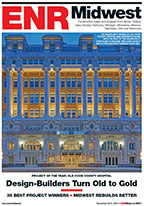...in 2010 include what the federal government does with healthcare, which public-construction projects get federal stimulus money, and how various markets served by industrial companies rebound.
“What the federal government does about the healthcare system will have a huge impact on construction in that sector. Many projects are waiting to see how the proposed legislation comes out,” he says.
One ongoing concern for Lavallee and his organization’s members is a potential shortage of trained construction workers when the industry does turn around. He notes that experienced baby boomers are retiring and young people may be reluctant to enter an industry where work is slow.
Mark Wight, CEO of Wight & Company, Darien, Ill., says, “2010 will be all about doing more with less—focusing on organizational efficiencies and helping clients do the same.”
“All markets are stressed, but there are projects being designed and constructed in federal, infrastructure, energy and sustainability,” Wight says. “Firms will have to work harder than ever to win, as competition is fierce and large firms are now pursuing smaller projects in all markets. Additionally, the economic stimulus plan has not trickled down as much as we had hoped.”
“In these uncertain times,” says Wight, “it is critical to become more efficient and position your firm to come out strong at the end of the economic downturn—which unfortunately doesn’t appear to be 2010.”
Paul James, senior vice president at Bovis Lend Lease, Chicago, also sees the recovery coming later than 2010. Says James, “The quarter ending in September, 2009, has seen stabilization in the construction market, and there is a perception that we are at the bottom of the downturn. Construction markets, however, are weak, and it is likely that recovery will not truly start until 2011.”
Pat Goss, executive director of the Wisconsin Transportation Builders Association, Madison, Wis., says that although federal stimulus money will continue to help road and bridge projects in 2010, there will likely be less of it than in 2009.
“What the road-building industry really needs,” says Goss, “is for the federal government to ramp up long-term investment to highway construction.”
A longer-term financial commitment, says Goss, would bring stability to the sector and let designers and contractors confidently make decisions that have long-term implications, like purchasing capital equipment.
Ron M. Clarkson, president of Alter Construction, Skokie, Ill., says he doesn’t expect the market to come back substantially until there is job growth and residential inventories are used up.
Describing Alter’s strategy, Clarkson says, “We’re trying to focus on existing client relationships, and, where possible, negotiate contracts as opposed to bidding on them. We continue to identify opportunities in niche markets like healthcare and education.”
Clarkson also believes Alter’s ability to provide a full range of services, from consulting, to development, construction, and building management, helps in any market environment.
Based on key indicators and the educated opinions of construction industry leaders, the beginning of 2010 will continue to be difficult for construction in the Midwest. Recovery will not start until at least the last half of the year, and it will seep in slowly over as many as five years.



Post a comment to this article
Report Abusive Comment